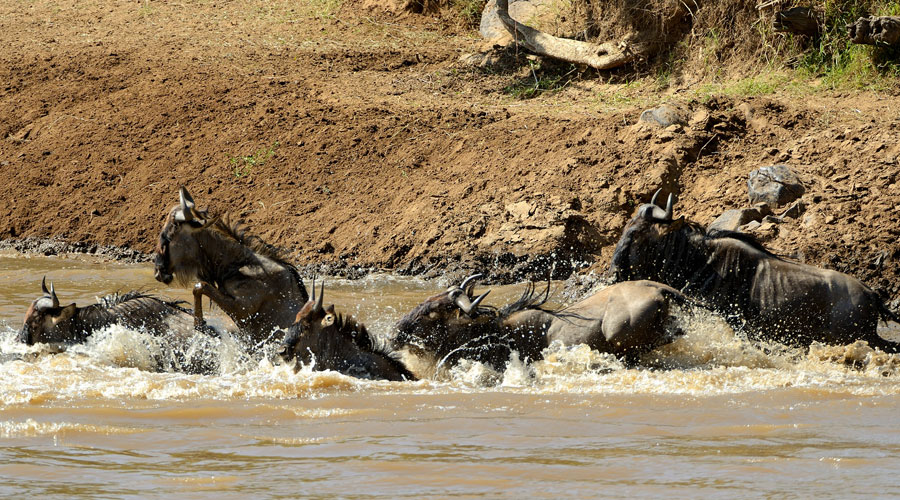The Gnu Migration

The Gnu Migration
The Great Wildebeest Migration from Tanzania to Kenya and back is the biggest migration in the animal kingdom. Hundreds of thousands of wildebeests and zebras move in a circuit across the Serengeti and arrive at Masai Mara in July. There the herds stay till the end of September. During this impressive journey, you go on Bernhard Grzimek’s trails whose book “Serengeti must not die” is today more topical than before. However, other fantastic animal sightings are planned as well, for example at Rift Valley, in the Kenyan high plains, and at the Samburu pan. Discover Kenya’s secrets on this great safari together with our experienced safari team.
Itinerary
Day 1: Arrival in Kenya and drive to Masai Mara
Day 1: Arrival in Kenya and drive to Masai Mara
Arrival at Nairobi airport where you are welcomed by your driver-guide. Drive along the East African Rift to the Northern Serengeti. Your destination is a tented camp at the Telek river. Under an exhilarated starry sky, you listen to the breath of nature. Overnight at Tipilikwani Mara Camp. (D)
Day 2 – 3: Intensive Masai Mara
The Masai Mara National Reserve is Africa’s region with the most animals. Between July and September, the Mara turns into an open-air theatre. On search of green areas in the savannah more than one million wildebeests, zebras, gazelles, and their hunters – the lions – move from the Southern Serengeti to Masa Mara. There, nature explodes after the rainy season. Apart from constantly moving herds of wildebeest there live a lot of other animals at Masai Mara year-round. On long game drives, you are able to observe different species of antelopes, giraffes, lions, and leopards. Overnight at Tipilikwani Mara Camp. (B/L/D)
Day 4: Drive to Lake Nakuru
After a last morning game drive, you continue your journey to the Rift Valley. You arrive at Lake Nakuru which is home of temporarily up to two million flamingos. The soda lake is also famous for its versatile bird worlds such as for pelican, egret, and cormorant. After nightfall, you go on an exciting night safari in the national park. Overnight at Mbweha Camp. (B/L/D)
Day 5: Game drives at Lake Nakuru National Park
A complete day is planned to explore Lake Nakuru National Park. Apart from the more than 450 species of birds that live here, the park is home to rare mammals such as the Rothschild’s giraffe, white and black rhinos. Overnight at Mbweha Camp. (B/L/D)
Day 6: Thomson Falls and drive to Mount Kenya
Drive to Nyahururu, with 2,300 meters above sea level Kenya’s highest city. There are the Thomson Falls where a hike along the waterfalls is planned. Afterward, you continue to the plateau between the Aberdare mountain range and Mount Kenya. Here lies Rhino Watch Lodge in a picturesque location. All tents have a magnificent view of Kenya’s highest mountain – Mount Kenya. Overnight in an exclusive safari tent at Rhino Watch Safari Lodge. (B/L/D)
Day 7: Solio Game Reserve
An orchestra consisting of more than 100 bird species wakes you up in the morning. You go on safari at Solio Game Reserve. Not far from the lodge with more than 126 animals you can find the biggest population of black and white rhinos in Africa. This makes the reserve a perfect place to observe the second biggest mammal on land. The three to four tons weighting and up to two-meter-tall pachyderms love the open savannah. Overnight in an exclusive safari tent at Rhino Watch Safari Lodge. (B/L/D)
Day 8: Aberdare National Park
Discover the mysterious mountain forests of Aberdare National Park. Named after Lord Aberdare the Aberdare mountains with its waterfalls, vast forests and moorlands are a welcome change to the well-known savannah. In this nearly untouched East-African refugium there live African forest elephants and various species of apes. If you are lucky you meet lions and leopards. Overnight in an exclusive safari tent at Rhino Watch Safari Lodge. (B/L/D)
Day 9: Ol Pejeta Conservancy
At today’s safari you can observe several rare species. At the Ol Pejeta Conservancy, you can meet one of the last three northern white rhinos who live here with their private rangers. If you are lucky you can also discover the other Big Five as well as the almost extinct African wild dogs. Unusual residents of the park are chimpanzees who have found a new home in the local orphanage after being rescued from the black market. Of course, a visit to this project which is part of the Jane Goodall foundation is planned as well. Overnight in an exclusive safari tent at Rhino Watch Safari Lodge. (B/L/D)
Day 10: Samburu National Park
Samburu National Park is located in the North of Kenya. In the morning you again leave Rhino Watch Safari Lodge and drive to the Samburu pan. Your comfortable camp is situated directly next to the river. Often the elephants sleep next to the tents. Overnight in Elephant Bedroom or Samburu Lodge. (B/L/D)
Day 11: Samburu National Park
Full day game drive at Samburu National Park. The park is an ideal habitat for elands, gerenuks, Grant’s gazelles, two species of dik-diks and plains, and Grevy zebras. Furthermore, the park is famous for its giant herd of elephants, waterbucks, leopards, and lion sightings. Overnight in Elephant Bedroom or Samburu Lodge. (B/L/D)
Day 12: Nairobi
After the last game drive and a great breakfast, it’s time to prepare for your journey back home. Transfer to Nairobi for your return flight. (B)
